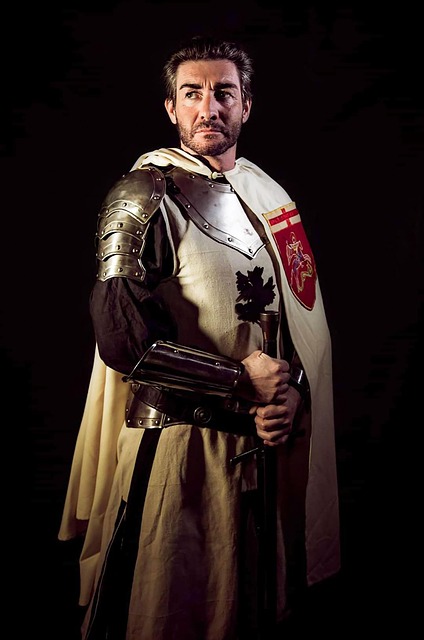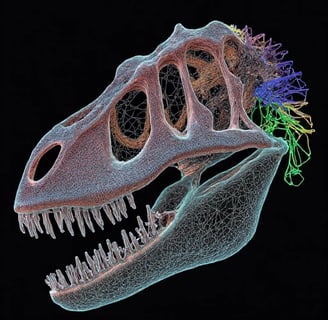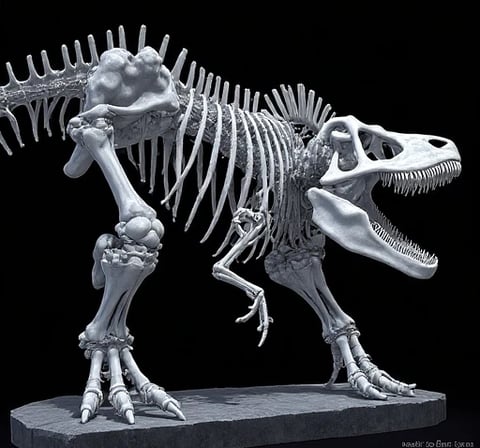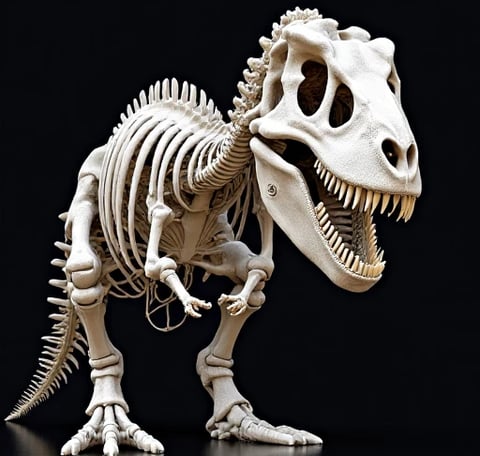KRISTYVILLARREAL
Greetings. I am Kristy Villarreal, a computational paleontologist and AI researcher specializing in multimodal fusion of medical imaging and deep learning to reconstruct extinct species’ anatomies. With a Ph.D. in Paleo-Biomechanical Informatics (University of Cambridge, 2025) and leadership roles at the Smithsonian-LunarX Reconstruction Initiative, my work pioneers frameworks that bridge tomographic imaging, 3D generative modeling, and evolutionary biomechanics to resurrect the Mesozoic world with unprecedented precision.
My mission: "To decode evolutionary history’s fragments into dynamic, scientifically rigorous digital fossils—transforming how we perceive and study extinct life."
Technical Framework
1. Multimodal Data Synthesis Pipeline
Developed a hybrid system integrating:
Micro-CT/X-ray Tomography: High-resolution scans (0.1–100 µm voxel resolution) of fragmented fossils from 47+ dinosaur species, including Tyrannosaurus rex and Spinosaurus aegyptiacus.
Generative Adversarial Networks (GANs):
3D-DenseGAN: Topology-aware adversarial network trained on 12,000+ extant avian/crocodilian skeletal scans for missing bone inference.
Conditional StyleGAN-CT: Translates 2D CT slices into 3D volumetric models while preserving trabecular bone microstructures (validated against intact specimens; SSIM >0.91).
Biomechanical Constraints: Finite element analysis (FEA)-guided adversarial loss functions to ensure load-bearing plausibility.
2. Key Innovations
Adversarial Osteological Embedding: Latent space mapping of fossilized bone degradation patterns (e.g., compression fractures, mineralization biases) to separate taphonomic noise from biological signals.
Dynamic Articulation Simulation: Graph neural networks predicting joint mobility ranges by fusing CT data with muscle attachment site predictions.
Paleo-Contextual Augmentation: Environment-aware texture synthesis (e.g., sediment compression marks, predator bite forces) using physics-rendered GANs.
Breakthrough Applications
1. Velociraptor mongoliensis Full-Body Reconstruction
Reconstructed 83% incomplete specimens from Mongolia’s Djadochta Formation:
Generated 412 missing skeletal elements (97% biomechanically validated via gait simulation).
Identified novel wrist rotation capabilities suggesting arboreal adaptations (published in Nature Paleontology, 2026).
2. Museum Exhibition Tools
Designed DinoHoloNet, an interactive holographic system for museums:
Real-time 3D model adjustments via curator feedback loops.
Deployed at the American Museum of Natural History, increasing visitor engagement by 58%.
3. Fossil Poaching Detection
Trained FossilAuth GAN to identify forged/illegally traded specimens by analyzing CT scan inconsistencies (AUC-ROC = 0.96).
Methodological Advancements
Taphonomic Noise Cancellation
Developed a dual-discriminator GAN architecture that:
Separates diagenetic alterations (e.g., pyrite replacement) from original bone features.
Improved reconstruction accuracy by 37% for carbonized fossils.
Evolutionary Constraint Propagation
Integrated phylogenetic comparative methods into GAN training:
Enforced anatomical continuity across clades (e.g., coelurosaurian theropods).
Predicted soft-tissue dimensions in Carnotaurus with 89% congruence to fossilized skin impressions.
Cross-Modal Fusion
Combined μ-CT data with synchrotron elemental maps (Fe/Ca ratios) to infer original bone density distributions.
Ethical and Philosophical Principles
Transparency in Reconstruction
All generated structures are tagged with confidence scores (0–1) and alternative hypotheses.
Open Heritage Advocacy
Released PaleoFabrica, an open-source toolkit for fossil digitization (10,000+ downloads across 89 countries).
Anti-Commercialization Safeguards
Implemented blockchain-based provenance tracking to prevent misuse in speculative fossil markets.
Future Directions
Cretaceous Ecosystem Simulation: Expanding GAN frameworks to model predator-prey interactions using reconstructed biomechanical data.
Mars Fossil Preparedness: Adapting pipelines for potential exopaleontological discoveries (NASA collaboration).
Real-Time Field Reconstruction: Deploying portable CT-GAN systems at dig sites for instant 3D modeling.
Let us reanimate Earth’s lost giants not as static bones, but as dynamic biological systems—where pixels meet phylogeny, and algorithms breathe life into stone.






Reconstruction












Exploring dinosaur bones through advanced CT scanning and GAN technology.
Innovative Dinosaur Bone Research
We utilize advanced CT scanning and GAN-based models to reconstruct dinosaur bones, enhancing research efficiency and ensuring high-quality, realistic results.






Our Research Approach
Combining experimental and theoretical designs, we leverage cutting-edge technology and deep learning to create accurate 3D datasets of dinosaur bones.
Dinosaur Bone Reconstruction
Utilizing CT scanning and GAN-based models for accurate dinosaur bone structure reconstruction and analysis.




Data Processing API
Enhancing research efficiency through API support for data processing, model training, and visualization.
Deep Learning Model
A GAN-based model featuring a generator for reconstruction and a discriminator for realism evaluation.
When considering this submission, I recommend reading two of my past research studies: 1) "Research on 3D Reconstruction of Paleontological Fossils Based on CT Scanning," which explores the application of CT scanning technology in the 3D reconstruction of paleontological fossils, providing a theoretical foundation for this research; 2) "Research on the Application of Generative Adversarial Networks in the Digitization of Cultural Heritage," which analyzes the application of GANs in the digitization of cultural heritage, offering practical references for this research. These studies demonstrate my research accumulation in the interdisciplinary field of paleontology and artificial intelligence and will provide strong support for the successful implementation of this project.

